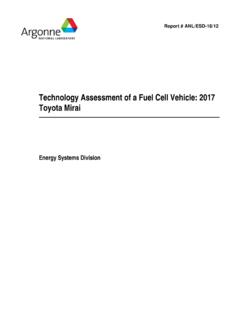Transcription of Perspectives on Hydrogen for Airports and Aviation ...
1 Federal AviationAdministrationPresented to:H2@ Airports Workshop By:Dr. James I. HilemanChief Scientific and Technical Advisor for Environment and EnergyOffice of Environment and EnergyFederal Aviation AdministrationDate: November 4, 2020 Perspectives on Hydrogen for Airports and Aviation ApplicationsFederal AviationAdministrationEconomic Benefits of Aviation (pre-pandemic)SOURCE: International Trade $ Trillionin economicactivity annually$ Billion of Trade Balance (exports-imports) equipment (aircraft, spacecraft, and related equipment) is largest export sector in economy accounting for over 8% of total.
2 FAA Air Traffic Organization2 Federal AviationAdministrationEnvironmental Impacts of Aviation3 Combustion EmissionsFederal AviationAdministrationAirport CO2 Emissions Airports have a variety of non-aircraft energy users that produce emissions Hydrogen could be used to replace / augment these energy sources ( , aircraft ground support equipment, ground fleet, electricity generation, backup power) However there are significant challenges (below points are from M. Pagliarelloof ACI-NA) Beyond safety, which is always a concern, other issues include funding, storage, and delivery.
3 To date, a few Airports have done cursory analysis on potential for Hydrogen , and they found hurdles too large to pursue. The most extensive study is currently being conducted at London Heathrow, which is expected to provide information that will be informative for other Airports around the world. 4 Large Hub Airport Scope 3 CO2 EmissionsAirport Controlled CO2 Emissions (Large Hub Airport)Federal AviationAdministrationAviation Noise Many communities are concerned about noise from aircraft and helicopters operations Public could have similar concerns with noise from unmanned aerial systems ( drones)
4 And advanced air mobility vehicles Electrification could enable dramatic changes in vertical lift vehicles Depending on design choices, could get a step change reduction in vehicle noise Changes in number of lifting fans, fan geometry, and the use of ducts for the fans Batteries or Hydrogen fuel cells could be a key enabler to this change in vehicle architecture Choice of primary energy source will depend on specific needs of the air vehicle, ( , range, payload, refueling time, total energy needs)5 Federal AviationAdministrationAircraft Energy To enable long distance transport, aircraft need considerableenergy storage while also producing considerable power To produce this power, an Aviation fuel needs large energy per unit mass and volume For use in long distance aircraft, Hydrogen would either need to be cryogenic or used in a power-to-liquid fuel , ( , electrofuelsthat use renewable H2and CO2) Aviation also has stringent safety requirements see ASTM D1655 & D7566 for jet fuel6 Neat Power-to-Liquid fuel (SPK)
5 Cryogenic Hydrogen Upper graphic from 2016 National Academies report, Commercial Aircraft Propulsion and Energy Systems Research: Reducing Global Carbon Emissions. (FAME)(FAME)Fuels that Use HydrogenJet FuelFederal AviationAdministrationELECTROFUELHYDROGE NA irports as Energy Hubs (1 of 2) Commercial service Airports handle large quantifies of jet fuel (Los Angeles International uploads ~100,000 barrels of jet fuel per day) Transportation and handling of fuel needs to be a key consideration 7 BATTERY-ELECTRICJETFUELAIRPORT BOUNDARYON-SITE POWER GENERATIONBATTERY CHARGINGREFININGFOSSIL,WASTE, OR BIOMASS FEEDSTOCKTRANSPORTREFUELINGOFFSITE POWER GENERATIONT ransmission systemELECTROLYSISLIQUEFACTIONCRYO STORAGEOFF-SITE POWER GENERATIONON-SITE POWER GENERATIONREFUELINGH2 GAS PIPELINEELECTROLYSISCARBON CAPTURE + fuel CONVERSIONOFF-SITE POWER GENERATIONREFUELINGTRANSPORTELECTRICITYL IQUID H2 GASEOUS H2 LEGENDLIQUID JET FUELG raphic courtesy of F.
6 Allroggen of MIT from ASCENT Project 52 See AviationAdministrationAirports as Energy Hubs (2 of 2) Replacing jet fuel with cryogenic Hydrogen would require considerable electricity to electrolyze water and compress it to a cryogenic state Power-to-liquids would require comparable energy as cryogenic Hydrogen , but without requiring infrastructure changes8 Preliminary Results from Ongoing Research in ASCENT Project 52 for flights greater than 1,000 kmPreliminary data courtesy of F. Allroggen of MIT from ASCENT Project 52 See AviationAdministrationAdditional Considerations Placement of liquefaction facilities will be a challenge for cryogenic Hydrogen use at Airports Physical delivery of cryogenic Hydrogen from tank farm or liquefaction facility to individual aircraft will also be extremely challenging Hydrogen combustion in commercial Aviation could exacerbate climate challenges due to NOXemissions and Aviation induced cloudiness Going from today s Aviation fuels to another fuel type requires many Airports to have the new fuel type available for
7 Upload while Hydrogen could make sense for an individual airport, it would have to make sense for many Airports across varied geographic regions before it could be used extensively in civil Aviation FAA are supporting MIT through ASCENT Project 52 to conduct a detailed systems analysis to help us understand the relative merits of different ways that commercial Aviation could use electricity in Aviation , this including Hydrogen and PTL produced from renewable electricity9 Federal AviationAdministrationAnother Use for Hydrogen in Aviation Hydrogen gas is required for petroleum refining and conversion of biomass and wastes to sustainable Aviation fuels Using renewable Hydrogen for fuel production would provide an immediate reduction in the carbon footprint of Aviation and enable the use of sustainable Aviation fuelsPath Forward with Hydrogen in Aviation There are considerable waste and biomass resources in the that could be sustainably produced.
8 At lower costs than either cryogenic Hydrogen or power-to-liquids, and that would use today s infrastructure1 Makes logical sense to use these resources now and to leverage our current infrastructure In the future, if we need more jet fuel than can be provided from waste and biomass resources, then power-to-liquid fuels could be a viable solution. It could be produced from renewable electricity via Hydrogen as an intermediary while enabling us to use our existing infrastructure101. For additional details on potential for wastes as a SAF feedstock, see: AviationAdministrationConcluding Thoughts New vertical lift vehicles, enabled by new energy sources, could open up opportunities for urban air transport and reduce noise relative to conventional helicopters Opportunities for new energy sources exist at Airports to reduce emissions from the airport terminal, ground operations at the airport, and ground support equipment MIT through ASCENT COE Project 52 are examining potential paths for using renewable electricity in Aviation The best use of renewable Hydrogen for Aviation could be to green refining processes today.
9 Enable the use of a wider range of feedstocks in the near future, and lay groundwork for production of power-to-liquids in the longer term11 For more information on ASCENT Project 52, please AviationAdministration12Dr. Jim HilemanChief Scientific and Technical Advisor for Environment and EnergyFederal Aviation Administration Office of Environment and EnergyEmail.












